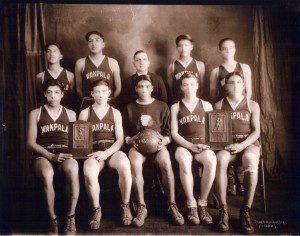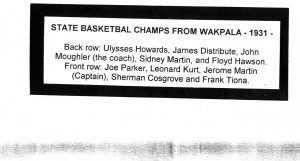The Arrival of Native American Basketball Players and The 1931 South Dakota State Basketball Tournament
THE ARRIVAL OF NATIVE AMERICAN BASKETBALL PLAYERS
Basketball teams were organized at several high schools with pre-dominately Native American students during the early 1920s. The schools included state funded public schools, as well as, both federally funded public schools, and mission boarding schools operated by religious communities. St. Francis Mission on the Rosebud Reservation, and Holy Rosary Mission, located on the Pine Ridge Reservation, were both operated by the Jesuit Fathers. Their basketball programs both began in 1924.
Participation in playing basketball was accepted quite readily by the Native American student populations. By the mid 1920s, the Catholic Mission schools participated in National Catholic basketball events in as far away places as Chicago. The Native Catholic Tournaments at Chicago Loyola were organized much like the National tournaments organized by the University of Chicago. Native American teams from South Dakota participated in the tourney until its demise at the beginning of World War II.
Native American teams participated in the district and regional tournaments sponsored by the South Dakota Athletic Association. The first team with several Native American players to make it to a State Tournament was the Wakpala team of 1931. Wakpala, the Region Two champions, played in the State Tournament at the Corn Palace in Mitchell.
1931 SOUTH DAKOTA STATE BASKETBLL TOURNAMENT ACCOUNTS, MITCHELL EVENING REPUBLICAN
The following accounts of the 1931 South Dakota State Boys Basketball Tournament, from the Mitchell Evening Republican, March, 1931, document the appearance and performance of African American players from Yankton, and Native American basketball players from Wakpala and Waubay. These players were the subject of special description and coverage by Mitchell Evening Republican reporter, Paul Swensson.
Mitchell Evening Republican, March 11, 1931
WAKPALA BRINGS INDIAN PLAYERS ON STAR TEAM
By Paul Swensson
Bring a pocket pronouncing dictionary with you to the state tournament. One glimpse at the list of players submitted by the eight coaches of the eight teams would enthuse anyone on the glories of why folks come to South Dakota.
A survey of the list of basketball boys appears to omit Chinese, Fiji Islanders and Eskimos. All the rest are represented in a glorious concoction of names. The royal art of basket making is blessed with the absence of an announcer who would have developed a case of fractured tonsils before he finished the two-day tournament Friday and Saturday from which the state court champion will be picked.
From Yankton’s colored boys to the Indian lads from Wakpala there is everything that ever came from Europe or any other continent. From the list of eligible players submitted by the coaches yesterday here are the lads:
Waubay: Earl Bradberry, Roy Humbracht, Harold Schultz, Harold Barfe, Donald Englehart, Earling Iverson, Howard Thompson, Orville Darrington, and William Hovland.
Wakpala: James Distribute, Sherman Cosgrove, Leonard Kurt, Jerry Martin, Sidney Martin, Frank Tiona, Joseph Parker, Floyd Howson, Ulysses Howard, Bennie Cramer.
Watertown: Bertrand Aus, Jerry Cope, Roger Evans, Dale Freeburg, Arthus Fredericks, Francis Garberding, Curtis McLaughlin, Robert Walrath, Glenn Wagner, Berdin Wishhart, Harold Mooney, Maurice McGrann
Miller: Paul Bohning, George Callahan, Ray Dorenberger, Marion Dennis, Dean Rose, Boyd Ulrich, M. Stensland, B. Van Cleave, Lindgren.
Madison: Tom Miller, Robert Buck, Wilmar Wiese, Homer Appelwick, Maynard Holter, Donald Stanford, Elliot Kurth, Elmer Ravell, Clifford Mativick, John Moe, C. Gregorson.
Parkston: Franklin Gorman, Herberty Neumeyer, Albert Gorman, Horace Adkins, Francis Springer, Marvin Weidenbach, Clement Mogck, Albert Pietz, Anton Neumeyer, Elmer Brown, Frank Isaak, Harvey Boegler, and Joe Welling.
Yankton: Ray Hamann, Stanley Smith, Leslie Ruud, Floyd Schenk, Francis Livingstone, Chester Beaver, Fred Ray, Art Hayes, Glenn Smith and Jack Sinclair.
Lead: Paul Akrop, Cyril Allen, Alfred Cappa, John Aker, Wallace Furz, Howard Kurtti, Joe Marasovich, George Olson, John Radovich, Sam Ruzick, Elton Urban, Frank Veronda, Raymond Veronda, Leslie Vines, and John Vupovich.
And if that doesn’t try your pronouncing abilities nothing else will.
Note: We believe the black players for Yankton were Art Hayes and Stanley Smith.
Mitchell Evening Republican, March 12, 1931
WATERTOWN AND MILLER PRY LID OFF TOURNEY TILTS AT 2:30 FRIDAY
The injuns are coming and with flying torso and racing extremities, the young Braves from the North are stampeding an old battle cry, “Beat Yankton.”
That tune is a wild, bitter cry, re-echoing from one end of the state to the other. The Indian lads in Waubay and Wakpala having heard of the failure of the 25 clubs which have fallen before the Terrible Buck have rallied to the cause and are mapping a battle plan which will be revealed in the Corn Palace, Friday and Saturday.
For Yankton has exterted a weird charm over the control of the state championships. Since 1922 the Bucks have hog tied the title and pulled off the bacon with monotonous regularity.
Here’s the record. Starting in 1922, the Bucks hauled home the title jewelry like a thermometer. ’22, 23, 24, 25, 28, 29. Last year the Bucks finished second best to Huron. This March the down state lads figure the titles in the bucket save for the necessity of playing the required games.
Wakpala and Waubay bring the Injuns. Wakpala has a quint that is a red skin terror. The record of the reservation lads is not “being shouted from the housetops, but the lads have whooped it up till they stood at the top of the district and region.
Waubay, besides having Lofty Humbracht, has an Indian or two as scouts, Waubay and Wakpala bang off in the first round in the final game of the evening.
Lead renews its championship threats after a leave of absence lasting 13 years from title consideration. Lead took the silver pottery emblematic of the title back to the Hills in 1918, and since then hasn’t done much in the way of winning cups, and now faces, the rangy Parkston quint in the first round, with Yankton holding an edge over Madison by virtue of two wins over the presidents.
When all is said and done, it may be that these lads from the north with their Indian side kicks will end the Yankton threats for glory. Tell you about it tomorrow night and Saturday.
Mitchell Evening Republican, March 13, 1931
Fan Vanguard Arrives Early For Cage Frays
… Drawing particular attention as they showed up around town was the Wakpala team of Indian boys from the Reservation in Corson county. The main attraction on the Indian team is a lanky lad by name of James Distribute, and that kid knows how to distribute the ball to the hoop, whoopeee, la la!


March 14, 1931
WAUBAY STAGES COMEDY AFFAIR AS INJUNS STAR
The luck of the draw saved the comedy until the closing round of the first day of basket ball in the state tourney. It remained to Wakpala and Waubay to furnish the fans with the cheery good night, and it took some lanky Indian boys to turn the trick at that.
By the way, the score of the game was 21-17 in Waubay’s favor, thus making Waubay the next candidate to be guillotioned by the Yankton slaughterers.
The score and the outcome of the Waubay-Wakpala game meant little to the 5,000 fans who jammed the Corn Palace for the evening entertainment.
For one thing, the folks had come to see Lofty, the boy can see the other side of the sun and who knows what a basket looks like from the top. Lofty Humbracht almost got into trouble last night. He left the floor once and just about caught his chin on the rim of the basket and his feet were left hanging within two inches of the floor. Somehow he made the descent and during the remainder of the game, he was content to keep both digits anchored on the floor.
The trouble with Lofty is that his head is so far from the floor that if he loses his balance he gets dizzy, and sort of sea sick. At any rate the long geared boy was clearly off form and was reputed to be ill. His health was good enough for four baskets unassisted, and he was the high point man of the evening.
When the curiosity about Lofty began to subside, a couple of Indian lads began to draw the spotlight. There was the clever Distribute, who played opposite Lofty and who staged a smart side show. He handled the ball in blind man, bluff style and kidded the Waubay team for half the game with exceptional results. Then when he tired of faking this and that, he dug up some long shot artillery. He started it with a sensational shot from way beyond the center of the floor, a good two thirds the length of the court. It was a terrific heave, and the pumpkin sailed through the air and through the hoop for the record shot of the tournament.
Then Johnny Martin, another Indian lad, bethought himself and standing in the center’s circle tossed in a second record long shot just a moment after Distribute’s heave. Pretty shots, both of them, and the fans liked it. This Martin and Distribute, playing nonchalant ball apparently indifferent to either winning or losing, managed to tie up Waubay’s score every other minute, and it was not until Lofty got to work in the final quarter with a couple of ‘drop ins’ that Waubay had the game won.
Wakpala’s starting lineup had three Indians and two white boys. Waubay was not left out in the cold either. Beside having Lofty, it had a clever Indian lad, Barse, who played a nice floor game.
The officials, Nichols and Miller appeared to enjoy the game, chatting along the entire route with caustic comment on the evening’s specialty.
Humbracht had 4 FGs. Distribute had 3 FGs and 1 FT. John Martin had 3 FGs.
Mitchell Evening Republican, March 16, 1931
Mythical all-state team of players from State Tournament teams.
Forwards: Stanley Smith, Yankton; Maynard Holter, Madison; Floyd Schenk, Yankton
Centers: James Distribute, Wakpala; John Rodovich, Lead
Guards: Ray Hamann, Yankton; Robert Buck, Madison; George Olson, Lead
Distribute, Wakpala’s Indian star, and Radovich elongated lead center, each received six votes for the center position. …
The cleverest ball handler of the tournament was Distribute. His antics threw the opposition off guard for his passes might go anywhere. He was proficient with either hand and on bounce passes used “English” to place the ball where he wanted it. His defensive play was good.
